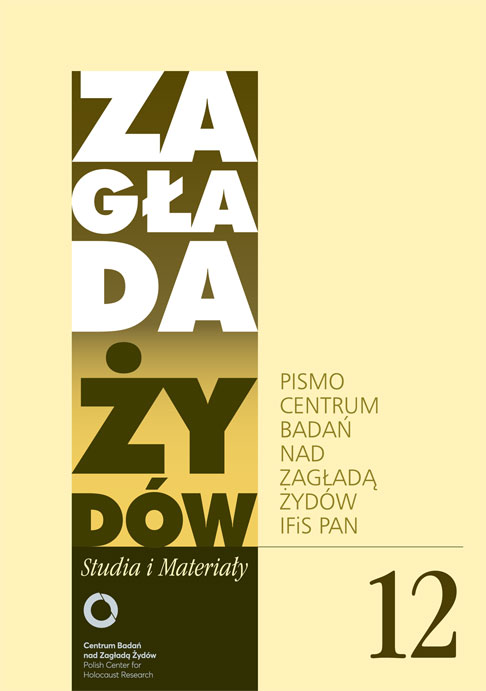“Ever New Demands, Ever New Grimaces” – the Power and Subordination Relation between Poles and Jews Hiding on the ‘Aryan’ Side
Zagłada Żydów. Studia i Materiały, No. 12 (2016), Pages: 209-241
Submission Date: 2020-10-19Publication Date: 2016-11-30
 https://doi.org/10.32927/ZZSiM.413
https://doi.org/10.32927/ZZSiM.413
Abstract
This texts talks about three single, uneducated Polish women living alone (a dressmaker, servant, and kitchen worker), who during the war sheltered Jews in their apartments in Warsaw and Drohobych. All three of them helped the Jews for money, but – as far as we know – none of them resorted to financial blackmail or any other major abuse of a financial character. Nevertheless, the war circumstances became an opportunity for them to fulfill their emotional needs, otherwise impossible to satisfy. They derived pleasure from having power and control over another person and their actions towards the Jews they sheltered also bore traces of a class revenge. The authors analyze the relations between the helpers and helps mostly on the basis of Jerzy Feliks Urman’s diary and memoirs of Karol Rotgeber and Calek Perechodnik. Aside from the sociological theory of exchange systems, another useful tool facilitating comprehension of the Polish women’s behavior and their interactions with the Jews in hiding, which are described in those texts, is Erich Fromm’s concept of human cruelty as a highly complex phenomenon that cannot be reduced to openly violent actions.
Keywords
diary , memoir , ‘Aryan’ side , hiding Jews , dominance and subordination relation , Warsaw , Drohobycz
License
Copyright (c) 2016 Author&"Holocaust Studies and Materials"

This work is licensed under a Creative Commons Attribution 4.0 International License.
https://creativecommons.org/licenses/by/4.0
The journal is published under the Diamond Open Access Standard, CC-BY-4.0 Deed - Attribution 4.0 International - Creative Commons
Most read articles by the same author(s)
- Justyna Kowalska-Leder, Polish Literature of the Last Decade about the Holocaust – Attempts to Face the New Challenges , Zagłada Żydów. Studia i Materiały: No. 10 (2014)
- Justyna Kowalska-Leder, Called by Their Name’ or Harm and Justice , Zagłada Żydów. Studia i Materiały: No. 18 (2022)
- Justyna Kowalska-Leder, Fetishization of Authenticity – The Casus of the Museum and Memorial Site , Zagłada Żydów. Studia i Materiały: No. 17 (2021)
- Justyna Kowalska-Leder, Helping Those Doomed to Annihilation as a Source of Destruction – On the Basis of Brandla Siekierkowa’s Personal Documents , Zagłada Żydów. Studia i Materiały: No. Holocaust Studies and Materials (2013)
- Justyna Kowalska-Leder, Omnipresence of the Righteous , Zagłada Żydów. Studia i Materiały: No. 10 (2014)
- Justyna Kowalska-Leder, Helping Those Doomed to Annihilation as a Source of Destruction – On the Basis of Brandla Siekierkowa’s Personal Documents , Zagłada Żydów. Studia i Materiały: No. 8 (2012)
- Justyna Kowalska-Leder, Troublesome Category – On the book Świadek: jak się staje, czym jest? , Zagłada Żydów. Studia i Materiały: No. 16 (2020)
- Justyna Kowalska-Leder, Three models of trust towards non-Jews on the Aryan side , Zagłada Żydów. Studia i Materiały: No. 20 (2024)
- Justyna Kowalska-Leder, rEVIEW: Reprezentacje Zagłady w kulturze polskiej (1939–2019). Problematyka Zagłady w sztukach wizualnych i popkulturze, t. 1–2, red. Sławomir Buryła, Dorota Krawczyńska, Jacek Leociak, Warszawa: Wydawnictwo IBL PAN, 2021, 672 s. , Zagłada Żydów. Studia i Materiały: No. 18 (2022)
- Justyna Kowalska-Leder, The Omnipresence of the Righteous , Zagłada Żydów. Studia i Materiały: No. Holocaust Studies and Materials (2017)
Similar Articles
- Havi Dreifuss, Secret Cities. A Few Remarks on Gunnar S. Paulsson’s Methodology , Zagłada Żydów. Studia i Materiały: No. 10 (2014)
- Barbara Engelking, The Memoir of Doctor Chaim Einhorn, a Physician from a Warsaw Ghetto Hospital , Zagłada Żydów. Studia i Materiały: No. Holocaust Studies and Materials (2017)
- Barbara Engelking, Memoir of Doctor Chaim Einhorn , Zagłada Żydów. Studia i Materiały: No. 11 (2015)
- Marta, Procedures Reversing Circumcision Performed in Warsaw During World War II. An Initial Attempt at Description , Zagłada Żydów. Studia i Materiały: No. 13 (2017)
- Bella Gutterman, On Her Guard – Zivia Lubetkin on the Aryan Side of Warsaw and during the Warsaw Uprising , Zagłada Żydów. Studia i Materiały: No. 8 (2012)
- Jan Grabowski, Hunting down Emanuel Ringelblum. The Participation of the Polish Kriminalpolizei in the ‘Final Solution of the Jewish Question , Zagłada Żydów. Studia i Materiały: No. Holocaust Studies and Materials (2017)
- Jan Grabowski, Tracking Emanuel Ringelblum. Participation of Polish Kriminalpolizei in the “Final Solution to the Jewish Question” , Zagłada Żydów. Studia i Materiały: No. 10 (2014)
- Editors Journal, Jan Grabowski, From the editors , Zagłada Żydów. Studia i Materiały: 2010: Holocaust Studies and Materials
- Jacek Leociak, Censorship Keeping Guard over the Church. Krystyna Modrzewska’s Censored Memoir , Zagłada Żydów. Studia i Materiały: 2010: Holocaust Studies and Materials
- Jan Grabowski, Lea Balint, The Diary of Hinda and Chanina Malachi , Zagłada Żydów. Studia i Materiały: 2008: Holocaust Studies and Materials
1 2 3 4 5 6 7 8 9 10 11 12 13 14 15 16 17 18 19 20 21 22 23 24 25 26 27 28 29 30 31 32 33 34 35 36 37 38 39 40 41 42 43 44 45 46 47 48 49 50 > >>
You may also start an advanced similarity search for this article.
 English
English
 Język Polski
Język Polski



 https://orcid.org/0000-0003-4727-4431
https://orcid.org/0000-0003-4727-4431

